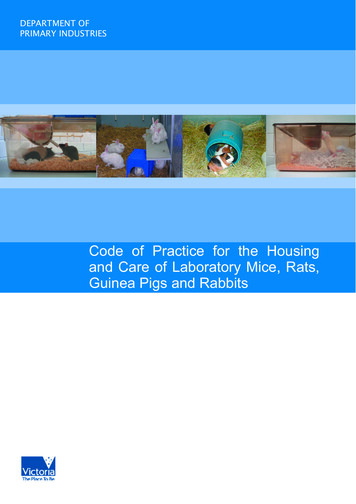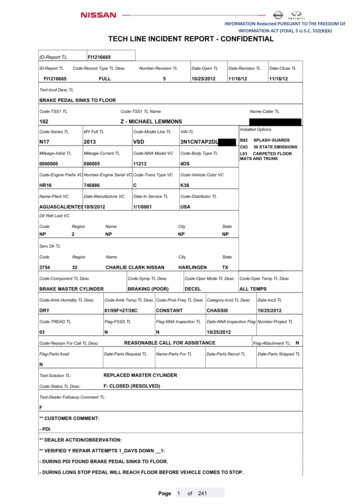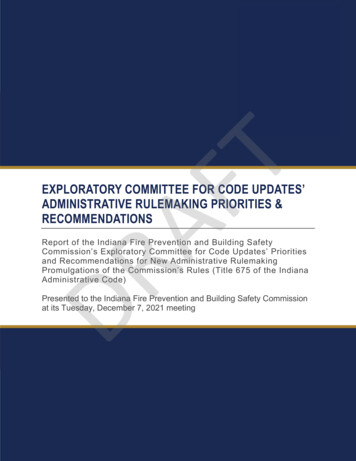
Transcription
DEPARTMENT OFPRIMARY INDUSTRIESCode of Practice for the Housingand Care of Laboratory Mice, Rats,Guinea Pigs and Rabbits
Acknowledgements“The Bureau of Animal Welfare would like to acknowledge the input of the Code writing group, andMonash University for the provision of a number of example monitoring appendices. Cover photographycourtesy of Monash University, University of Melbourne and Walter Eliza Hall Institute”Code of Practice for the Housing and Care of Laboratory Mice, Rats, Guinea Pigs and Rabbits.Published by the Victorian Government Department of Primary Industries475-485 Mickleham RoadAttwood Victoria 3049 AustraliaTelephone: 61 3 9217 4200Facsimile: 61 3 9217 4299Also published on http://www.dpi.vic.gov.au/animalwelfareApproved by the Governor in Council 12 October 2004.Issued by the Minister of Agriculture Prevention of Cruelty to Animal Act 1986Published in the Victorian Government Gazette, 16 December 2004 The State of Victoria, Department of Primary Industries, 2004.This publication is copyright. No part may be reproduced by any process except in accordance with theprovisions of the Copyright Act 1968.Authorised by the Victorian Government1 Spring StreetMelbourne Victoria 3000 AustraliaISBN 1 74146 288 6For further information, visit the DPI Website at http://www.dpi.vic.gov.auor contact the DPI Customer Service Centre on 136 186DisclaimerThis publication may be of assistance to you but the State of Victoria and its employees do not guaranteethat the publication is without flaw of any kind or is wholly appropriate for your particular purposes andtherefore disclaims all liability for any error, loss or other consequence which may arise from you relyingon any information in this publication.
Code of Practice for the Housing and Careof Laboratory Mice, Rats, Guinea Pigs andRabbitsDepartment of Primary Industries
4
Code of Practice for the Housing and Careof Laboratory Mice, Rats, Guinea Pigs andRabbitsContents page1. Introduction, Purpose and Scope of this Code . 72. Definitions and Acronyms . 83. Principles, Minimum Standards and Recommendations for the Housingand Care of Laboratory Mice, Rats, Guinea Pigs and Rabbits . 103.13.23.33.43.53.63.73.83.93.10Nutrition . 103.1.1 Food . 133.1.2 Water. 14Animal Enclosures . 153.2.1 Materials and design . 173.2.2 Space requirements. 173.2.3 Social requirements . 193.2.4 Bedding and nesting . 193.2.5 Special requirements . 20Climate Control . 203.3.1 Temperature . 213.3.2 Relative humidity . 233.3.3 Ventilation and air quality . 233.3.4 Noise and vibration . 263.3.5 Light . 273.3.6 Emergency plans and alarm systems . 28Behaviour and Environmental Enrichment . 283.4.1 Behaviour . 293.4.2 Environmental enrichment and complexity . 29Maintenance and Hygiene . 32Handling and Basic Procedures. 33Health Monitoring . 35Transportation . 36Euthanasia . 37Monitoring and Records . 394. Further Information Sources . 41Code of Practice for the Housing and Care of Laboratory Mice, Rats, Guinea Pigs and Rabbits5
Contents page continue.AppendicesAppendix 1Appendix 2Appendix 3Appendix 4Appendix 5Appendix 6Appendix 7Appendix 8Appendix 9Appendix 106Minimum standards for housing of laboratory mice, rats, guinea pigs andrabbits .44Methods of euthanasia for post-neonatal laboratory mice, rats, guinea pigs andrabbits .47Guidelines for euthanasia of fetal and neonatal mice, rats, guinea pigs andrabbits .50Example Animal monitoring sheet .52Example Welfare assessment score and judgement sheet.56Example Monitoring sheet for animals after surgery or invasive procedures .58Example Daily breeding record sheet .60Example Monthly animal record sheet .62Example Numerical score sheet for neonatal genetically modified rodents .64Example Phenotype report for genetically modified and/or cloned animals .66
1.Introduction, Purpose and Scope of this CodeThe ‘Code of Practice for Housing and Care of Laboratory Mice, Rats, Guinea Pigs andRabbits’ applies throughout Victoria. It establishes minimum standards for the housing andcare of these animals under The Prevention of Cruelty to Animals Act 1986 (The Act) andRegulations 1997. This code is intended to be read in conjunction with the current AustralianCode of Practice for the Care and Use of Animals for Scientific Purposes (The AustralianCode).Minimum standards in this code will be enforceable, as it is a mandatory ‘code of practice’under Part 3 of The Act. Proposed variations to these standards, as part of an experimental orbreeding protocol, must be justified to and approved by an Animal Ethics Committee.The recommendations serve to provide further guidance and should be promoted whereverpossible to achieve practice above and beyond the minimum standards.This document has been developed in collaboration with a number of laboratory animalveterinarians, animal technicians, animal house managers, inspectors and animal welfareofficers from academic and research institutions and private industry. This consultationensured that wide experience and specialised knowledge relevant to this animal industry inVictoria formed the basis of the information presented herein. Relevant international codes,guidelines, standards and references were also considered as were submissions from theVictorian Animal Welfare Advisory Committee and a period of public comment. This is thefirst code of its type and content in Australia.It should be noted that this code is not intended as an exhaustive source of information on thehousing and care of the four species covered. For example, details of dietary requirements,structural requirements of animal rooms and animal handling and basic procedures are notincluded as it was felt that an overly prescriptive document would not best serve the widevariety of institutions and situations in which it has relevance.Appendices 4-10 provide examples of various monitoring sheets that are currently usedin some institutions and may be recommended to assist in monitoring and recording ininstitutions in general.It is intended that this code will assist a wide spectrum of people involved in the use of animalsin scientific procedures to ensure that minimum standards of animal care, housing and welfareare achieved and that recommendations of ‘best practice’ and the ‘three Rs’ of Russell andBirch - Replacement, Reduction and Refinement - are promoted wherever possible. As newinformation on how best to house and care for these laboratory animals becomes available, thecode will be updated and reviewed by the Bureau of Animal Welfare.Code of Practice for the Housing and Care of Laboratory Mice, Rats, Guinea Pigs and Rabbits7
2.Definitions Abnormal Stereotypy: A repeated sequence of movements, which has no obviousfunction.Animal Ethics Committee (AEC): A committee, the principal function of which is todetermine the ethical and animal welfare practices that are to apply to the carrying outof scientific procedures. This committee must be constituted in accord with the terms ofreferences and membership laid down in The Australian Code.Animal welfare: An animal’s quality of life based on an assessment of an animal’sphysical and psychological state as an indication of how the animal is coping with itscircumstances.Best practice: Best practice is that which is agreed at a particular time, followingconsideration of scientific information and accumulated experience. It is a higherstandard of practice than the minimum standard.Clone: A genetic copy of another living or dead animal. It is not a twin derived from thefertilisation of an egg by a sperm.Euthanasia: the humane killing of an animal, in the interests of its own welfare, toalleviate pain and distress (see humane killing).Genetic modification (of an animal): the use of any technique for the modification ofgenes or other genetic material, but not including the use of natural processes such assexual reproduction.Genotype: The genetic constitution of an individual.Humane killing: the process of killing an animal with minimal pain and distress (seeEuthanasia).Investigator or teacher: Any person who uses animals for scientific procedures.Microbiological Barrier: a combination of animal handling procedures and housingwhich enables the animals’ microbiology to remain constant over time (ie. biocontainmentor bioexclusion).Phenotype: Appearance and behaviour of an organism resulting from interactionbetween its genome and its environment.Project: A single program of scientific procedures as defined under Section 25 of TheAct.Standard Operating Procedure (SOP): Detailed description of a standardisedprocedure.The Act: The Prevention of Cruelty to Animals Act 1986.The Australian Code: The Australian Code for the Care and Use of Animals forScientific Purposes (current edition). 8
Acronyms AEC: Animal Ethics Committee.ACH: Air changes per hourANZCCART: Australian and New Zealand Council for the Care of Animals inResearch and Teaching.ANZSLAS: Australian and New Zealand Society for Laboratory Animal Science.AQIS: Australian Quarantine Inspection Service.AVA: Australian Veterinary Association.IATA: International Air Transport Association.IBC: Institutional Biosecurity CommitteeIVCs: Individually Ventilated Cages (ie. microisolators)NHMRC: National Health and Medical Research Council.OGTR: Office of the Gene Technology Regulator.PC: Physical Containment (level).Code of Practice for the Housing and Care of Laboratory Mice, Rats, Guinea Pigs and Rabbits9
3. Principles, Minimum Standards and Recommendations for the Housing andCare of Laboratory Mice, Rats, Guinea Pigs and RabbitsMice and RatsThe laboratory mouse and rat are derived from a largely nocturnal burrowing and climbingancestor who favoured building nests for temperature regulation and reproduction. As such,they retain many of the traits of their wild counterparts, for example, grooming, exploratoryactivity, searching for food, burrowing, climbing and gnawing. Housing systems should aim toencompass these behavioural and physiological needs.These animals have relatively poorly developed vision, but highly developed senses of smell andhearing. Rats, in particular, are very sensitive to ultrasound. Laboratory rats and mice are verysocial animals, and as such, disruption to groups should be minimised. Young rats, in particularare very exploratory and active, and interact socially to an enormous degree.Guinea pigsGuinea pigs may appear nervous but are tame and can be handled easily. Vocalisation appears toplay an important part in guinea pig social and sexual behaviour, and they often call for attentionfrom animal care staff. They naturally thrive in family or weaner groups, and although maleguinea pigs may fight, aggression between sexes is uncommon. Guinea pigs can be housed forbreeding in pairs or harems and the young are fully developed at birth. Weaning takes place at2-3 weeks, but generally the young are eating solid food and water within a few days of birth.RabbitsComparative studies of domesticated rabbits living in groups in large enclosures have shownthat they retain a wide behavioural repertoire, similar to their wild ancestors. There is increasingevidence to show that rabbits denied the freedom of natural behaviour and exercise can losenormal locomotor activity and suffer skeletal abnormalities. Within the practicalities of laboratoryhousing of rabbits, an environment adequate to allow performance of a wide behaviouralrepertoire should be provided. The rabbit is a naturally gregarious species so attention shouldbe paid to their social wellbeing. These requirements are preferably met by housing rabbits inpens.3.1Nutrition3.1.1FoodAll four species practice coprophagy; the ingestion of a special faecal pellet coated inmucus. They are cautious feeders, often avoiding unfamiliar foods. These animals haveconstantly erupting teeth and interference to wear will lead to malocclusion, whichcauses difficulty with eating and swallowing.10
Guinea pigs are unable to synthesise vitamin C (ascorbic acid) in sufficient quantity tomeet their daily requirements. Insufficient Vitamin C intake will lead to debilitation,increased susceptibility to disease and eventually to scurvy. Guinea pigs, in particular,do not like change in their diet.Minimum Standards for Nutrition:(i)Laboratory animals must receive a palatable diet, which is free fromcontaminants and provides the nutritional requirements appropriate to thespecies, age and breeding stage of the animal.(ii)Food must be stored in cool, vermin-proof rooms under conditions thatprevent it from becoming a health risk to the animals.(iii)Communication between investigators and animal house staff must bemaintained concerning any supplementation or manipulation of diets.(iv)Diets for guinea pigs must fulfil their vitamin C and E requirements.(v)Consideration must be given to the type of presentation of food when feedingyoung or handicapped animals.General Recommendations:(i)In the selection, production and preparation of food, precautions should be takento avoid chemical, physical and microbial contamination to ensure that food is safefor the animals and their young. All food hoppers and utensils should be cleanedregularly and sterilised when necessary. All fruit and vegetable supplements shouldbe appropriately washed prior to presentation to the animals.(ii)It is recommended that feeding of young or handicapped animals (for example; thosepost-surgery or with muscular dystrophy) be facilitated by provision of food in aPetrie dish or hand-feeding as necessary.(iii)When moist food is used, it should be replaced regularly to ensure palatability andfood safety.(iv)The animal house manager or a laboratory animal veterinarian should be consultedprior to supplementation or manipulation of complete commercial diets.(v)Consideration should be given to the rotation of use and storage of formulated dietssuch that they are used within the recommendations of the manufacturer (particularlyformulated diets supplemented with Vitamin C).(vi)Food used in microbe-controlled environments is often autoclaved to avoid theintroduction of food-borne pathogens. As autoclaving decreases the concentrationsCode of Practice for the Housing and Care of Laboratory Mice, Rats, Guinea Pigs and Rabbits11
of some vitamins and antioxidants, diets should be based on formulations that containhigher concentrations of heat-labile ingredients.(vii)Where animals are held in groups, care should be taken to ensure that subordinateanimals have sufficient access to food and water. It is recommended that more than oneaccess point for food (and water) be provided to reduce the possibility of aggressivecompetition.(viii)Any significant changes in food intake should be investigated.Species Specific Recommendations:(i)(i)Mice:Consideration should be given to the presentation of food for certain animals that haveabnormalities of the teeth and jaw.Guinea Pigs:Taking into consideration autoclaving or irradiation requirements, Vitamin C can besupplied in the pelleted ration (800mg/kg finished diet) or supplemented in the drinkingwater (1g/litre), prepared fresh daily. Fresh vegetables can also be used to provideVitamin C and should be thoroughly washed prior to presentation.(ii)Guinea pigs have a high dietary fibre requirement (16%) which is best met by supplyingthem with good quality lucerne hay. They should be provided with a diet of 20% minimalprotein.(iii)The feed should be appropriately stored to maintain active levels of Vitamin C. As aguide, one half of the Vitamin C may be lost 90 days after the diet has been commerciallymixed and stored above 22ºC.(iv)Guinea pigs are susceptible to anorexia following experimental procedures and mayrequire special attention to resume eating. The use of a pellet mash mixed with waterand hand fed to guinea pigs will often be sufficient for normal appetite to be resumed.A faecal pellet can be included to restore microbiological activity in the digestive tractafter periods of anorexia.(v)Consideration should be given to the type or placement of the feed hopper outside thecage to control wastage of food and contamination of the feed with faeces.(i)12Rabbits:It is recommended that foods such as hay, fruits, vegetables, legumes or green feedsbe fed to supplement commercial pellets and to reduce the monotony of a fixed rationdiet.
(ii)A high fibre diet should be provided to help prevent diarrhoea and hairballs. A dietwith between 18-25% fibre is recommended.(iii)If a restricted diet is required to be fed to rabbits, it should be provided at routine times.3.1.2WaterMinimum Standards for Water Provisions:(i)Potable water must be available to all animals at all times.(ii)Precautions must be taken to avoid flooding in solid-bottomed cages.(iii)If Vitamin C is to be provided at effective levels in the water for guineapigs, a non-copper delivery system and daily preparation of the water mustbe used.General Recommendations:(i)The source and method of water supply should minimise microbial and chemicalcontamination.(ii)Under certain conditions of transport, water should be provided in the form of a moistdiet (see Section 3.8).(iii)Water bottles or containers should be sanitised or sterilised. They should be sufficientlytransparent to enable water availability to be easily checked and have a wide mouth tofacilitate cleaning. Water bottles or containers should always be replaced with clean,freshly filled ones and should not be able to easily tip or spill.(iv)Automatic watering systems should be serviced and cleaned regularly to avoidmalfunction and the risk of spread of infection, drowning or drought. This shouldinclude checking for the correct pressure in the drinking valves to prevent back-flowof water into the lines when animals drink from, or play with, the valve. The nipplesshould be located at a suitable height to enable access for all animals. Some animalsneed to be taught to use automatic watering devices.(v)These species are very susceptible to water deprivation. Water supply should bechecked daily and if a problem is confined to one cage/box, blockage of a wateringnipple or bottle should be considered as a cause in the first instance.Code of Practice for the Housing and Care of Laboratory Mice, Rats, Guinea Pigs and Rabbits13
Species Specific Recommendations:(i)Guinea Pigs:These animals often waste water by playing with the sipper and therefore automaticwatering systems are often not used. The sipper tube should be located outside the cageto prevent excessive wetting. If automatic watering devices are used, some animalsrequire training.Rabbits:(i)Open watering systems should be avoided to prevent infection of the dewlap.3.2Animal EnclosuresThe design of animal housing should facilitate well being of the animals, meetresearch requirements, minimise experimental variables, and isolate the animals fromwide variations in temperature and humidity and from vibration and sources of loudnoise. For detailed requirements of the design of animal rooms, refer to ‘Housing forLaboratory Rats, Mice, Guinea Pigs and Rabbits’, A.L. Hargreaves, ANZCCART 2000.Consideration should also be given to occupational health and safety requirements whendesigning animal housing.The formation of social groups, and utilisation of enrichment devices and beddingmaterial to enable climbing, burrowing, nesting, reproduction and thermoregulation areas important as provision of adequate cage space for these species. Mice, rats and guineapigs tend to avoid open spaces.Mice:Mice, in particular, like to compartmentalise their behaviours and often use urinemarking and bedding to assist.Rats:Rats enjoy standing on their hind legs and peering from their enclosures. They areexcellent climbers, utilising the full height of their housing, and also use urine spottingas a territorial marker.Guinea Pigs:Guinea pigs are timid, social animals and can be slow to adapt to change in theirenvironment. As these animals have a poorly developed capability for either jumpingor climbing, they may be housed in a relatively low walled, open topped pen or cage.Natural behaviours include stampeding which may be avoided by providing sheltered orhiding places, and avoiding sudden noise, disturbance or overcrowding.14
Rabbits:There is a need to provide enough space to permit rabbits to meet their species-specificneeds. This includes sufficient exercise for skeletal development (hopping, rearing upetc) and direct social contact with other compatible rabbits. Rabbits can be housed incages or floor pens. Pens are enclosures that allow for greater freedom of movementand expression of social behaviours. Cages are fully enclosed containers that mayrestrict freedom of movement and social interaction because of their size and possiblydesign. The advantages and disadvantages of housing rabbits in cages versus pens arediscussed comprehensively in the ‘Guidelines for the Housing of Rabbits in ScientificInstitutions’ developed by the NSW Animal Research Review Panel (see Section 4).These guidelines recommend the use of pens for housing laboratory rabbits.Minimum Standards for Animal Enclosures in General:(i)Animal enclosures (cage or pen) must meet or exceed the minimal spacerequirements outlined in this Code to permit reasonable freedom ofmovement and normal postural adjustments.(ii)Enclosures must be compatible with what is known of the behavioural andphysiological needs of the animals.(iii)Enclosures must be durable and provide a comfortable environment, bemaintained in good repair, be kept clean and be escape-proof.(iv)Enclosures must confine animals safely with easy access to food, water andventilation and enable easy monitoring and access to the animals.General Recommendations:(i)Size, design and materials used in the construction of animal enclosures may affectmany of the environmental factors normally controlled at room level and thusmay affect the characteristics of the microenvironment. Refer to Section 3.3 forrecommendations concerning climate control.(ii)Special containment facilities are required for the use of radioisotopes, infectiousagents and highly toxic substances. For specific requirements and recommendations,refer to appropriate guidelines.3.2.1Materials and Design of Animal EnclosuresThe different materials used for animal enclosures affect shading and social contactvia degree of transparency, as well as heat and noise conduction. Although mesh orwire floor cages may offer some advantages over solid floor cages, for example toreduce disturbance during cleaning and to reduce the risk of cage flooding, solid floorsprovide a more comfortable and insulated surface with a reduction of the risk of injury.Faulty mesh or wire floors and lids can lead to serious injuries.Code of Practice for the Housing and Care of Laboratory Mice, Rats, Guinea Pigs and Rabbits15
The design of housing, whether enclosed, such as ‘shoebox-style’ cages, or opentype designs such as pens, determine the air movement and rate of dissipation of heat.Filter tops exacerbate the effects on ventilation of an enclosed design. They raise thetemperature and relative humidity inside the cage and hasten the build-up of carbondioxide and ammonia.Minimum Standards for Materials and Design of Animal Enclosures:(i)Enclosures must be designed and made of materials that are comfortable andsafe for the animals, and withstand cleaning agents and techniques.(ii)Housing must enable easy monitoring of the animals.(iii)Nesting boxes (or equivalent) must be provided for breeding animals.(iv)Wire or mesh floors and lids must be carefully selected and maintained tominimise the risk of foot and leg injuries. A solid mat or suitable substratemust be provided.(v)Insect vectors of myxomatosis and calicivirus rabbit disease (ie. flies andmosquitos) must be prevented from entering rabbit enclosures.General Recommendations:(i)Ventilated racks and IVCs used to house laboratory rodents provide separation at the rackand cage level, respectively. Consideration should be given to the additional heat load,noise and draughts provided by these systems. Separation of the motorised componentsof such systems reduces noise and heat impacts.(ii)In the design of animal enclosures, consideration should be given to make the housingenvironment suitably complex or enriched (see also Section 3.4).Species Specific Recommendations:(i)(i)(i)16Mice:Wire lids for mouse cages should be carefully selected to prevent toe injuriesRats:Galvanised metal should be avoided in the long term for rats, due to excessive risk ofzinc toxicity.Rabbits:The ‘Guidelines for the Housing of Rabbits in Scientific Institutions’ (see Section 4.) isrecommended for principles of rabbit pen design. Provision for rabbits to withdraw fromothers should be provided, and subdivision to facilitate cleaning and catching animals inpens is recommended.
3.2.2Space requirements.For all species, it is recognised that social relationships, enclosure shape and internalfurnishings may be as important to the animal as overall size of the enclosure. Theshape of the cage or floor pen may contribute to the security and comfort of theanimals.Guinea Pigs:Guinea pigs prefer to lie down and stretch out and also to congregate around theperiphery of the enclosure. An elongated shape maximises the length of space andwall for the occupants and reduces the central more exposed space. Guinea pigs do notreadily climb, and can be housed in open topped pens or cages. They do sometimesstand up and should be provided with adequate height to do so.Rabbits:Rabbits like to lie down outstretched. They often stand upright, hop or play, which isessential for normal skeletal and social development.Minimum Standards for Space Requirements:3.2.3(i)Adequate space must be provided to allow animals to exercise, to maintainthe social stability of the group and to perform normal physiological andbehavioural activities.(ii)Stocking densities must be adjusted for different breeds, ages and growthof the animals.(iii)The details of space requirements are given in Appendix 1, where the stateddimensions refer to internal measurements of the animal enclosure. Animalhousing must comply with these dimensions with the exception of shortterm housing of animals post-weaning and prior to issue, provided there areno associated deficits in their welfare.(iv)All four species either climb or assume upright posture at times, which mustbe accommodated without hindrance by the height of the enclosure.Social requirements.The way in which the cage or pen is stocked has direct social and welfare consequencesfor the animals. Single housing will cause social deprivation and impacts on theanimal’s capacity to thermoregulate.Intense territoriality may be seen in reproductively active male animals. Castrationprior to puberty may prevent aggression and fighting. Pregnant and lactating femalesmay prove aggressive in nest defence. Some strains of rodents are more aggressivethan others, which results in fighting within groups.Code of Practice for the Housing and Care of Laborat
Code of Practice for the Care and Use of Animals for Scientifi c Purposes (The Australian Code). Minimum standards in this code will be enforceable, as it is a mandatory 'code of practice' . information on how best to house and care for these laboratory animals becomes available, the code will be updated and reviewed by the Bureau of .










